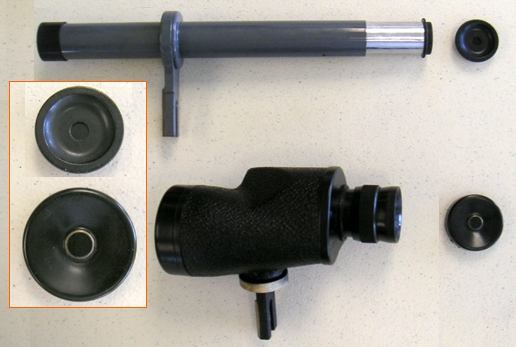|
Author
|
Topic: Sextant telescope eyepiece caps
|
David Burch
|
 posted February 21, 2005 12:36 PM
posted February 21, 2005 12:36 PM


One of the beauties of cel nav is you can study it a long time and still learn things... in this vein, i have just realized the true value of the sextant telescope colored eyepiece caps that accompany sextants from about 1960 and earlier, as shown in the picture below.

The scopes shown are a 6x30 monocular and a 15x20 inverting scope. The latter is used for index corrections only (or in the old days with an artificial horizon on land) and the former is for sun and moon sights. In some cases these are 35 or 40 mm lens and they might be presented as the main scope of the sextant.
These days the typical working scope is about a 4x40 used for all sights and possibly an optional 6x30 or 7x35 monocular for sun and moon sights and for checking the index error. Inverting high-power scopes are not seen at all on new sextants.
The 4x 40 scope might also include a shaded eyepiece cap on older units, but we did not have one to photograph, and they are not provided in new units that we know of.
Till recently, I had just thought of these eye caps as an optional way to add more shading to conventional sun sights on very bright days. In practice, however, this is not a realistic application, as there are not many situations where you migght want the exactly identical extra shading on *both* the horizon and the sun, which this type of cap over the telescope eyepiece would do.
And we might not learn more from text books. These eye caps are illustrated in older Bowditchs (1917 to 1938) but not discussed. They are also mentioned in Lecky's Wrinkles of Practical Navigation, but simply described there as "...should be neutral colors with a light tint." This description would be consistent with adding extra shading to normal sights, my first interpretation
The ones we have seen on many instruments, however, are very dark shades. The horizon would not even show up when viewed through them, so that is not the application.
The answer is, these are for doing solar index corrections as we describe in section 11.21 of the course book and in the online Resources library of articles, which also includes a form for the method. This is the most accurate way to get the IC for several reasons.
These eyepiece shades are ideal for this application. First you are looking at two views of the sun (one on top of the other), so you want essentially the same level of shade in direct and reflected views, and this telescope cap does the job by itself, without the need for other shades. When using these caps, all other shades are removed.
Second, since both light rays (reflected and direct) are going through the same glass shade, any distortion in the precision of the glass shade does not affect the accuracy of the final alignment. This is not the case when using a combination of horizon shades and index shades.
And third, with this cap over the eyepiece, your vision is protected from looking directly at the sun, which can be a hazard when using the standard movable filters, since it is sometimes possible to "see around" one of them and get a blast of sunlight.
This won't happen using the cap. With the cap in place, we can set the sextant to 0° 0' and hold it with the right hand to look up toward the sun, using the left hand to block out all other light, and this is a good way to find the sun to start the measurements.
So it is our conclusion that the answer to the question: What are those dark eye caps for? is — they are used when measuring the index correction with the sun, upper-limb to lower-limb method, which we have also called the "Lewis and Clark method," though we do not have any direct proof that they actually used this, but most likely did do so!
With this new insight, we need to update the solar IC article at first opportunity.
Also, with this insight in mind, we now have the task of finding where we can buy such things for modern sextants since they are no longer provided... this is part of the slow drift into obscurity of the entire subject... the nuances go first — the solar index correction method is a good way to trace the collapse.
In 1943 and earlier Bowditch editions, the method is presented with formulas, numerical examples, and detailed discussion. In 1958 the treatment has been reduced to a few sentences with nothing more; in 1977 edtion it is one line, and in the 2000 edtion it is gone entirely from the cel nav section, without a word.
Nevertheless, if we want to do the best at cel nav then these dark colored eye caps are a definite bonus. We will start asking around.
And needless to say, if anyone has any more info on these shade caps or their use, please post a reply. We have a perfectly good dead horse here, we might as well keep shooting it. Thanks.
--david
From: Starpath, Seattle, WA
|
|
|









